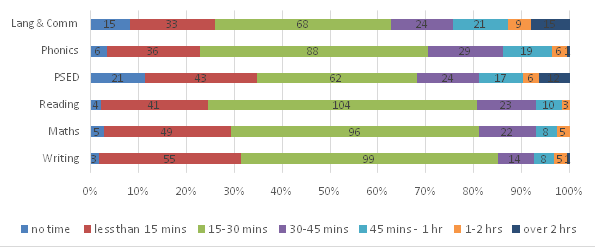Blog 4: Home learning
What areas of work and curriculum were families able to focus on during the spring 2020 lockdown?

From the responses to our online survey of parents and caregivers, we learned that most children were being supervised to learn across the curriculum, using an online device, on a daily basis.
In 80% of the families in our sample, an adult was available to supervise home learning, with 20% reporting some part-time availability. A variety of family members supervised home learning. 95% of respondents reported this being the mother, 46% the father, 12% older siblings, and 7% grandparents. Many families referred to ‘we’ in the open comments, indicating shared responsibility. In families where one parent was not working and thus did more of the home schooling (e.g. had a stay-at-home-parent role, was furloughed or on leave), this was often the mother.
Caregivers were asked how much time on average per day they spent on a number of key Early Years curriculum areas: language and communication; writing; phonics; reading; mathematics; and personal, social and emotional development. There were only small differences between the amounts of time spent on each curriculum area per day, as the table below shows.
 The average time spent on each area was between one and 30 minutes. It was highest for language and communication (defined as activities to help children express themselves and understand other people e.g. storytelling, role playing, giving and following instruction) at around 30 minutes per day. The lowest amount of time spent on average was for writing (defined as writing letter shapes, simple words such as the child's own name, or simple sentences which can be read by the child and others), at less than 15 minutes per day.
The average time spent on each area was between one and 30 minutes. It was highest for language and communication (defined as activities to help children express themselves and understand other people e.g. storytelling, role playing, giving and following instruction) at around 30 minutes per day. The lowest amount of time spent on average was for writing (defined as writing letter shapes, simple words such as the child's own name, or simple sentences which can be read by the child and others), at less than 15 minutes per day.
Of the reception children whose parents/carers said, in response to the survey, that they did some home learning, 96% had full or shared access to an electronic device or devices which could be used for learning. These could be a mobile phone, tablet, laptop or computer, or TV. Only 7 of the 185 respondents to this question in our survey had no access to these kinds of devices. 82 children did not have access to a laptop, and only 13 children had exclusive access to a laptop.
According to the respondents, 93% of our sample of reception-aged children had a space in which to do home learning activities, although, putting together a picture from other responses to the survey, we believe that many of them would be sharing that space with other family members, whether parents who were working from home, or siblings who also needed to do home learning activities. 5% had only part-time access to space in which to work, and 2% had none.
Motivation was a key factor impacting home learning. Families commented on the difficulty of motivating their children to engage in home learning:
It was difficult to put enough time into home schooling around work and also difficult to motivate XX to want to do school work at home when he would rather watch the TV
The very youngest children faced particular challenges in having to concentrate on school work whilst resisting distractions:
we broke the home learning down into two 45mins sessions due to the attention span of a 5 yr old being quite limited
Caregiver resourcefulness was at a premium. Some parents told us they simply didn’t understand the tasks that were set. Indeed, some aspects of the Early Years curriculum, such as elements of the phonics schemes of work, will be unfamiliar to caregivers. Other respondents had more confidence than others to improvise. For those who could find learning opportunities in everyday activities, e.g. counting cars during daily walks or building flat-pack furniture, family morale seemed to stay positive.
such as elements of the phonics schemes of work, will be unfamiliar to caregivers. Other respondents had more confidence than others to improvise. For those who could find learning opportunities in everyday activities, e.g. counting cars during daily walks or building flat-pack furniture, family morale seemed to stay positive.
Many families in our survey reported being unable to engage in home learning as much as they would have liked, due to challenging family circumstances, such as having to balance home learning with work, study, and caring simultaneously for children of different ages, including babies. Comments from caregivers revealed a challenging picture. Their responses often alluded to the lockdown period as ‘very tough’, ‘very hard’, ‘frustrating’, ‘stressful’, ‘a very hard time’, ‘very difficult’, ‘a nightmare’, ‘a struggle’, ‘impossible’, and ‘lonely’. Some families told us they found it difficult to complete all the tasks set by school, and expressed a degree of associated guilt about this.
Many families told us they prioritised mental wellbeing over completing tasks that school sent home:
we did crafts […]; lots of walks and takking [sic] about what we saw. She is read to every day. I felt this was more productive than formal teaching esp in these stressful times. Her mental health took priority
